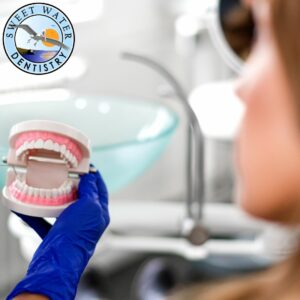How Is a Dental Crown Placed? A Step-by-Step Guide
A dental crown is a common restorative treatment that helps protect and strengthen a damaged or weakened tooth. Whether you have a cracked, broken, or severely decayed tooth, a crown can restore both its function and appearance. But what exactly happens during the placement of a dental crown? In this article, we will walk you through the step-by-step process of how a dental crown is placed, ensuring you know what to expect when visiting your dentist.
What Is a Dental Crown?
A dental crown is a tooth-shaped cap placed over a damaged tooth to restore its shape, size, strength, and appearance. Crowns can be made from various materials, including porcelain, ceramic, metal, and resin. They are custom-made to blend seamlessly with your natural teeth, providing a long-lasting solution for dental issues.
Reasons You May Need a Dental Crown
Your dentist may recommend a crown for several reasons, including:
- Protecting a weak or cracked tooth from breaking
- Restoring a broken or worn-down tooth
- Covering and supporting a tooth with a large filling
- Holding a dental bridge in place
- Covering a misshapen or severely discolored tooth
- Protecting a tooth after a root canal procedure
Now, let’s take a closer look at the step-by-step process of getting a dental crown.
Step 1: Initial Consultation and Examination
Before placing a dental crown, your dentist will examine your tooth to determine if a crown is the best solution. This may involve taking X-rays to assess the tooth’s condition and surrounding bone structure. If your tooth is severely decayed or infected, additional treatments like a root canal may be necessary before the crown placement.
Step 2: Tooth Preparation
Once your dentist determines that a crown is needed, they will begin the preparation process. This involves reshaping the tooth to make space for the crown. Depending on the extent of the damage, a portion of the tooth may need to be removed, or a filling may be placed to build up its structure.
The goal is to create a stable foundation for the crown to sit securely on the tooth.
Step 3: Taking Impressions
After shaping the tooth, your dentist will take an impression or digital scan of the prepared tooth. This mold ensures the crown fits perfectly and aligns with your bite. The impressions are sent to a dental laboratory where skilled technicians create a custom crown that matches the size, shape, and color of your natural teeth.
In some cases, dentists use advanced CAD/CAM technology to create same-day crowns, eliminating the need for a temporary crown.
Step 4: Placing a Temporary Crown
While waiting for the permanent crown to be fabricated, your dentist may place a temporary crown to protect the prepared tooth. This temporary crown allows you to eat and speak normally while preventing sensitivity or further damage. However, since temporary crowns are not as durable as permanent ones, you should avoid chewing sticky or hard foods during this period.
Step 5: Fitting and Cementing the Permanent Crown
Once the custom-made crown is ready, you’ll return to the dentist for placement. The temporary crown is removed, and the dentist will check the fit, shape, and color of the permanent crown. Adjustments may be made to ensure a comfortable bite and natural appearance.
Once everything is perfect, the crown is permanently cemented onto your tooth using a strong dental adhesive. Your dentist will then polish and fine-tune the crown to ensure a seamless blend with your surrounding teeth.
Step 6: Final Adjustments and Aftercare
After the crown is placed, your dentist will check your bite and make any necessary final adjustments. They will also provide you with care instructions to ensure the longevity of your new crown.
How to Care for Your Dental Crown
Taking care of your dental crown is essential for maintaining its longevity. Here are some key tips to keep your crown in excellent condition:
- Brush and floss daily to keep the surrounding gum tissue healthy
- Avoid chewing hard foods, ice, or sticky candies that could damage the crown
- Wear a nightguard if you grind your teeth at night
- Visit your dentist regularly for check-ups and cleanings
How Long Do Dental Crowns Last?
With proper care, dental crowns can last anywhere from 5 to 15 years or even longer. The longevity of your crown depends on factors such as the material used, your oral hygiene habits, and the amount of wear and tear it experiences.
Conclusion
Getting a dental crown is a straightforward process that restores the function and aesthetics of your smile. From the initial consultation to the final placement, your dentist ensures that the crown fits perfectly and provides lasting protection for your tooth. If you suspect you need a dental crown, schedule an appointment with your dentist today to discuss your options.
At Sweet Water Dentistry, we are dedicated to providing high-quality dental care to help you achieve a healthy, beautiful smile. Contact us today to learn more about our restorative dental treatments, including custom dental crowns.
Visit us for expert care:
Sweet Water Dentistry
📍 5915 Sweetwater Cir, Fairhope, AL 36532
🌐 sweetwatersmile.com
📞 Call or Text: (251) 210-2773
Follow us on Facebook and Instagram for the latest updates and special offers!
